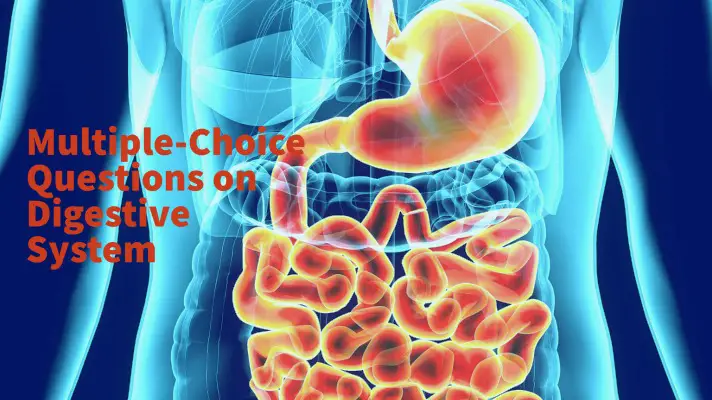Hello Readers! I hope that all of you are doing fine. I am here with a lot of Multiple-Choice Questions on Human Digestive System. While going through the Objective-type questions on Human Digestive System, you will come across some Amazing Facts about our Digestive System and these are quite interesting. Let’s enjoy ourselves by gaining more knowledge!
Further for getting the PDF version of this MCQ sheet in hand, click on the PDF downloadable button that you will get at the end of this article.

Multiple-Choice Questions on Human Digestive System
Here are some MCQ Questions on Human Digestive System:
- The process of digestion begins at the _.
- Annus
- Mouth
- Stomach
- Pancreas
Ans: (2)
- The process of digestion ends at the _.
- Annus
- Mouth
- Stomach
- Pancreas
Ans: (1)
- Which body organs contract and relax?
- Bones
- Teeth
- Enamel
- Muscles
Ans: (4)
- Which of the following mixes with food, softens it, and breaks it?
- Bile
- Saliva
- Pancreatic juice
- None of the above
Ans: (2)
- How much saliva is produced by an adult every day?
- 4-5.5 litres
- 3-4.5 litres
- 2-3.5 litres
- 1-1.5 litres
Ans: (4)
- Which of the following is an example of a powerful muscle?
- Teeth
- Tongue
- Lips
- None of these
Ans: (2)
- Which of the following are powerful crushers?
- Teeth
- Tongue
- Lips
- None of these
Ans: (1)
- Which one of the following moves the food towards the throat and turns food bits into a mass?
- Teeth
- Tongue
- Lips
- None of these
Ans: (2)
- Bolus is a:
- The liquid that mixes with food
- Saliva
- Mass of food bits
- None of these
Ans: (3)
- The function of the food pipe is:
- Transporting food from mouth to throat
- Transporting food from the mouth to the stomach
- Transporting food from mouth to intestine
- All of these
Ans: (2)
- How long is the food pipe for an adult?
- 15 cm
- 20 cm
- 25 cm
- 30 cm
Ans: (3)
- The gullet is a:
- Peptic
- Liver Juice
- Pancreas juice
- Food pipe
Ans: (4)
- Oesophagus is a:
- Gullet
- Peptic
- Liver Juice
- All of the above
Ans: (1)
- Peptic is a:
- One type of juice
- Liver Juice
- Pancreas juice
- All of the above
Ans: (4)
- The common opening for the windpipe and the food pipe is:
- Stomach
- Intestine
- Mouth
- Lips
Ans: (3)
- Epiglottis is located :
- In the windpipe
- In the food pipe
- At the junction of the windpipe and the food pipe
- In the mouth
Ans: (3)
- The function of the epiglottis is:
- To swallow the food
- To breathe in air and breathe out
- To chew the food
- To prevent the food particles from entering the windpipe.
Ans: (4)
- Our stomach is a:
- Heart-shaped
- “L” shaped
- “J” shaped
- None of the above
Ans: (3)
- Which of the following organ works like a food blender?
- Food pipe
- Teeth
- Liver
- Stomach
Ans: (4)
- How long can the stomach hold the food at a time?
- 2 litres
- 3 litres
- 4 litres
- 5 litres
Ans: (3)
- How long does the food stay in our stomach?
- 4 to 5 hours
- 3 to 4 hours
- 2 to 3 hours
- 1 to 2 hours
Ans: (2)
- The largest and heaviest internal organ of our body is:
- Stomach
- Liver
- Kidney
- Large intestine
Ans: (2)
- A thick, green secretion produced by the Liver is known as:
- Peptic
- Pancreas juice
- Bile
- All of the above
Ans: (3)
- Bile is secreted from:
- Stomach
- Kidney
- Liver
- Intestine
Ans: (3)
- How much is the weight of the liver for an adult?
- 0.5 kg
- 1 kg
- 1.5 kg
- 2.0 kg
Ans: (3)
- Bile is stored in the:
- Gall bladder
- Pancreas
- Small intestine
- Stomach
Ans: (1)
- How much pancreatic juice is produced by an adult in a day?
- 1 litre
- 1.5 litres
- 2.0 litres
- 2.5 litres
Ans: (2)
- Which intestine is longer in length?
- Small intestine
- Big intestine
- Both are equal in length
- It varies
Ans: (1)
- The length of a small intestine of an adult is approximately
- 1.5 m
- 3.0 m
- 5.5 m
- 7 m
Ans: (4)
- The length of a big intestine of an adult is approximately
- 1.5 m
- 3.0 m
- 5.5 m
- 7 m
Ans: (1)
- Which of the following organ holds the undigested part of the food?
- Anus
- Rectum
- Small intestine
- Large intestine
Ans: (1)
Quiz on Digestive and Excretory System
Here is the Quiz for you. It is completely free of cost. Don’t miss it. All the best!
Worksheet on Human Digestive System for Class 4
Fill in the blanks (5×1=5)
- __ like tapeworms do not have a digestive system.
- Ptyaline is a __.
- The function of Hydrochloric acid is __.
- __ in our body, contracts and relax.
- The food pipe is also known as __.
Answer the following: (5×2=10)
- Why should we not talk or laugh while eating food?
- Define the digestive system.
- Write a short note on Saliva and Bile
- When do we tend to get diabetes?
- Why should we drink water and how does it help our bodies?
Give some examples (5×3=15)
- Accessory digestive organs (any three).
- Main digestive organs (any three)
- Urinary organs (any three)
- Excretory organs (any three)
- Glands [definition and example(anyone)
Answers: A. Parasites, Carbohydrate digestive enzyme, killing infections, muscles, gullet or oesophagus.
Conclusion
I hope you all have enjoyed the Multiple-Choice Questions on Human Digestive System. This will surely help you in achieving a high score in your school examination / competitive examination. Wish you all the best! If you want MCQ questions on some other topic, please let me know by commenting or mailing me.


